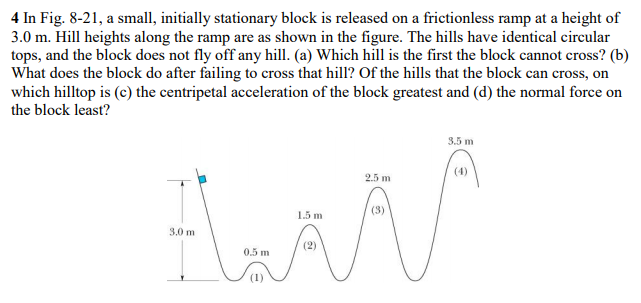e as shown. The hills have identical circular tops, and the block does not fly off any hill. (a) Which hill is the first hill that the block cannot cross? (b) What does the block do after failing to cross that hill? On which hilltop is (c) the centripetal acceleration of the block greatest and (d) the normal force on the
e as shown. The hills have identical circular tops, and the block does not fly off any hill. (a) Which hill is the first hill that the block cannot cross? (b) What does the block do after failing to cross that hill? On which hilltop is (c) the centripetal acceleration of the block greatest and (d) the normal force on the
Principles of Heat Transfer (Activate Learning with these NEW titles from Engineering!)
8th Edition
ISBN:9781305387102
Author:Kreith, Frank; Manglik, Raj M.
Publisher:Kreith, Frank; Manglik, Raj M.
Chapter5: Analysis Of Convection Heat Transfer
Section: Chapter Questions
Problem 5.59P
Related questions
Question
The figure shows a small, initially stationary block released on a frictionless ramp at a height of 3.0 m. Hill heights along the ramp are as shown. The hills have identical circular tops, and the block does not fly off any hill. (a) Which hill is the first hill that the block cannot cross? (b) What does the block do after failing to cross that hill? On which hilltop is (c) the centripetal acceleration of the block greatest and (d) the normal force on the block least?

Transcribed Image Text:4 In Fig. 8-21, a small, initially stationary block is released on a frictionless ramp at a height of
3.0 m. Hill heights along the ramp are as shown in the figure. The hills have identical circular
tops, and the block does not fly off any hill. (a) Which hill is the first the block cannot cross? (b)
What does the block do after failing to cross that hill? Of the hills that the block can cross, on
which hilltop is (c) the centripetal acceleration of the block greatest and (d) the normal force on
the block least?
3.5 m
(4)
2.5 m
(3)
1.5 m
3.0 m
(2)
0.5 m
Expert Solution
This question has been solved!
Explore an expertly crafted, step-by-step solution for a thorough understanding of key concepts.
This is a popular solution!
Trending now
This is a popular solution!
Step by step
Solved in 2 steps

Knowledge Booster
Learn more about
Need a deep-dive on the concept behind this application? Look no further. Learn more about this topic, mechanical-engineering and related others by exploring similar questions and additional content below.Recommended textbooks for you

Principles of Heat Transfer (Activate Learning wi…
Mechanical Engineering
ISBN:
9781305387102
Author:
Kreith, Frank; Manglik, Raj M.
Publisher:
Cengage Learning

Principles of Heat Transfer (Activate Learning wi…
Mechanical Engineering
ISBN:
9781305387102
Author:
Kreith, Frank; Manglik, Raj M.
Publisher:
Cengage Learning